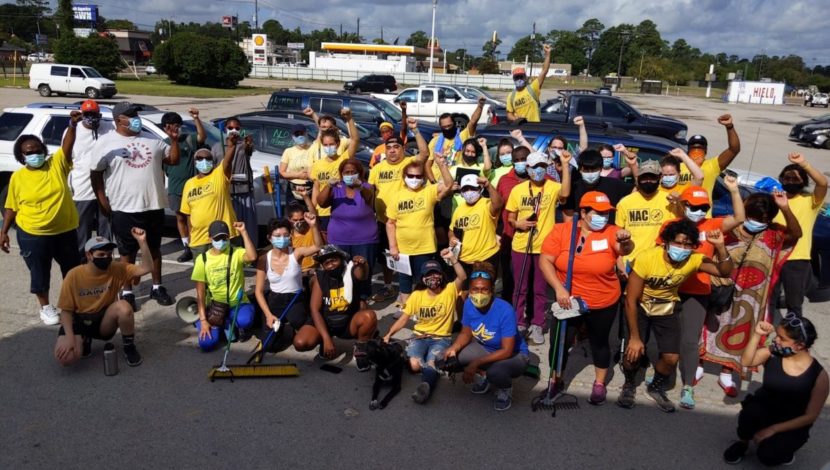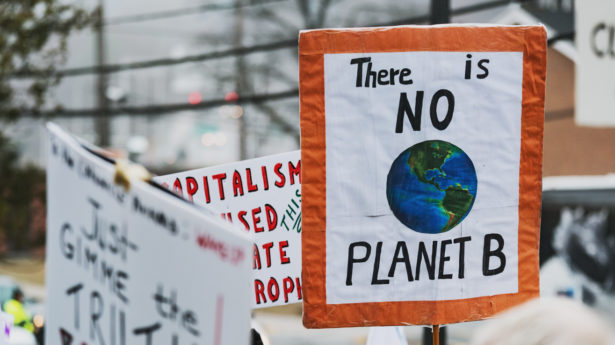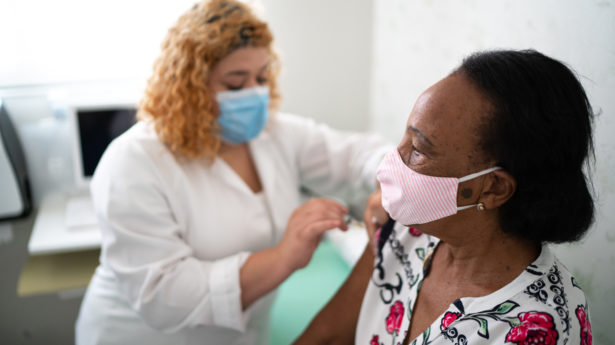The Unitarian Universalist Service Committee advances human rights through grassroots collaborations.
Disaster Justice: New Efforts to Define “Disaster” for Communities Facing Oppression

By Mike Givens on May 18, 2021
On May 6, 2021, UUSC and its allies The Praxis Project and Living Hope Wheelchair Association hosted an informative webinar to premiere a new, more inclusive definition of “disaster” and how local and federal governments, public health officials, and philanthropy can best respond to crises.
Understanding that common definitions of disaster—used by such institutions as the United Nations (UN) and the United States’ Federal Emergency Management Agency (FEMA)—typically refer to natural crises such as earthquakes, storms, hurricanes, tornadoes, and droughts, the group went about holding informative learning circles between May and October of 2020.
During these virtual sessions, more than 40 community-based organizations from across the United States came together to discuss just exactly what disasters are and how they best respond to them. The sessions used a learning model called popular education, a group dynamic that prioritizes the expertise and experiences of group members to facilitate learning. The popular education model lifts up the worth and dignity of group participants and acknowledges that the learnings these groups surface are a direct result of the diversity and complexity of those who participate.
During the six-month period, the group arrived at some critical conclusions.
Redefining Disaster
Participants came to the consensus that disasters are:
- Often human-made and can happen intentionally or unintentionally as a result of policy decisions;
- Opportunities to expose the inequalities many communities are already experiencing;
- Never experienced equally, but are often heavily felt by communities historically facing injustice such as immigrants, people of color, people with disabilities, and those who are housing insecure;
- Critical events that show how ineffective our systems are when providing services and resources;
- Experienced differently by different people;
- A means by which community members come to rely on public resources;
- Experienced on many different levels; and
- Opportunities for the public to temporarily feel sympathy for communities facing oppression, but stop feeling sympathy once the news cycle changes.
For example, the Living Hope Wheelchair Association, which provides services for people living with disabilities, has often observed that in the wake of severe storms such as hurricanes, immigrants, and people of color are often inadequately served by FEMA. The United States’ history of racial segregation, xenophobia, and income inequality not only serve as “pre-existing conditions” for people of color and immigrants, but also become clearly evident after a major disaster such as Hurricane Harvey, a Catergory 4 storm that devastated several parts of Texas and Louisiana. In the wake of that storm, these communities found themselves poorly served by FEMA and local governments when receiving resources and services.
The COVID-19 pandemic is another clear example of how disasters unearth the inadequacies of the systems we depend on. People of color, immigrants, the elderly, and low-income families were particularly hard hit throughout the pandemic. Access to services and resources were limited and the nation saw high mortality rates for people of color, particularly Black people. Low-income workers and families faced dire circumstances as businesses shut down and or laid off employees. The confluence of all these considerations highlighted a clear crisis in terms of public health and how capitalism is failing those with few to no economic resources.
Resiliency
The learning circles concluded that disasters often call communities into a sense of resilience in the face of adversity. Community-based organizations channel their resources into providing immediate relief in the form of food, toiletries, gift cards, and other forms of aid to stave off the impacts of disasters. These organizations create their own response plans to disasters to formalize processes for serving communities in the absence of support from government, public health officials, and philanthropy.
Participants also noted that in an ideal world, resiliency wouldn’t be necessary because communities wouldn’t face the systemic and institutional barriers that cause them to rally their resources. The dialogues lead community members to re-think the concept of resiliency and instead focus on autonomy. The concept of autonomy means that communities can re-envision their circumstances so as not to heavily rely on resiliency as a response, but autonomy as a way of being prior to a disaster even happening. If communities that have historically been oppressed can reimagine themselves as independent, they can better challenge traditional rules imposed by state and federal governments and demand policies that are fair and equitable. These communities can value themselves beyond traditional ways of thinking that measure their worth through how productive they are. Autonomy also means that these communities can resist toxic narratives that tell a harmful and misleading story about their circumstances.
For example, in the wake of a hurricane, a disaster response model rooted in justice demands that the communities most impacted are allowed to push back against local, state, and federal practices that limit how much aid they can receive. Communities will use the political system and their own storytelling and narratives to pressure governments to be more equitable in how they provide resources to people looking to rebuild. This model will also affirm the worth and power of those looking to rebuild their homes in the wake of the hurricane; their dignity will not be tied to how productive they are based on circumstances such as age, educational attainment, health, and annual income. Lastly, these community members have the agency to tell their own stories in the media and will not rely on mainstream news outlets to generalize their experiences or tell narratives that are harmful or victimizing.
Solutions
The learning circles came up with a series of conclusions tailored specifically for different audiences such as public health officials, community organizers, philanthropy, and policymakers. Some of the recommendations include:
- Broadening the definition of “disaster” to speak to human-made crises that contribute to the oppression of others;
- Lifting up the organizing and disaster response efforts of community-based organizations already serving communities facing injustice;
- Centering racial and social justice in disaster response efforts; prioritizing the diverting of financial and material resources to low-income, immigrant, and people of color communities will be key to addressing historic harms; and
- Moving away from the concept of resiliency and into the concept of autonomy, where we prioritize the dignity of all and re-build our systems to be more equitable.
UUSC fully endorses this approach and is keenly aware of how the crises we face are rooted in disaster. From people forcibly displaced from their homes due to political corruption and violence to entire communities that are forced to relocate due to climate change, the new concept of disaster helps us better understand how the systems and institutions we rely on are also complicit in the crises we experience. As we move forward, we will use this analysis to better serve our partners and their communities.
***
About UUSC: Guided by the belief that all people have inherent worth and dignity, UUSC advances human rights globally by partnering with affected communities who are confronting injustice, mobilizing to challenge oppressive systems, and inspiring and sustaining spiritually grounded activism for justice. We invite you to join us in this journey toward realizing a better future!
Image Credit: West Street Recovery

